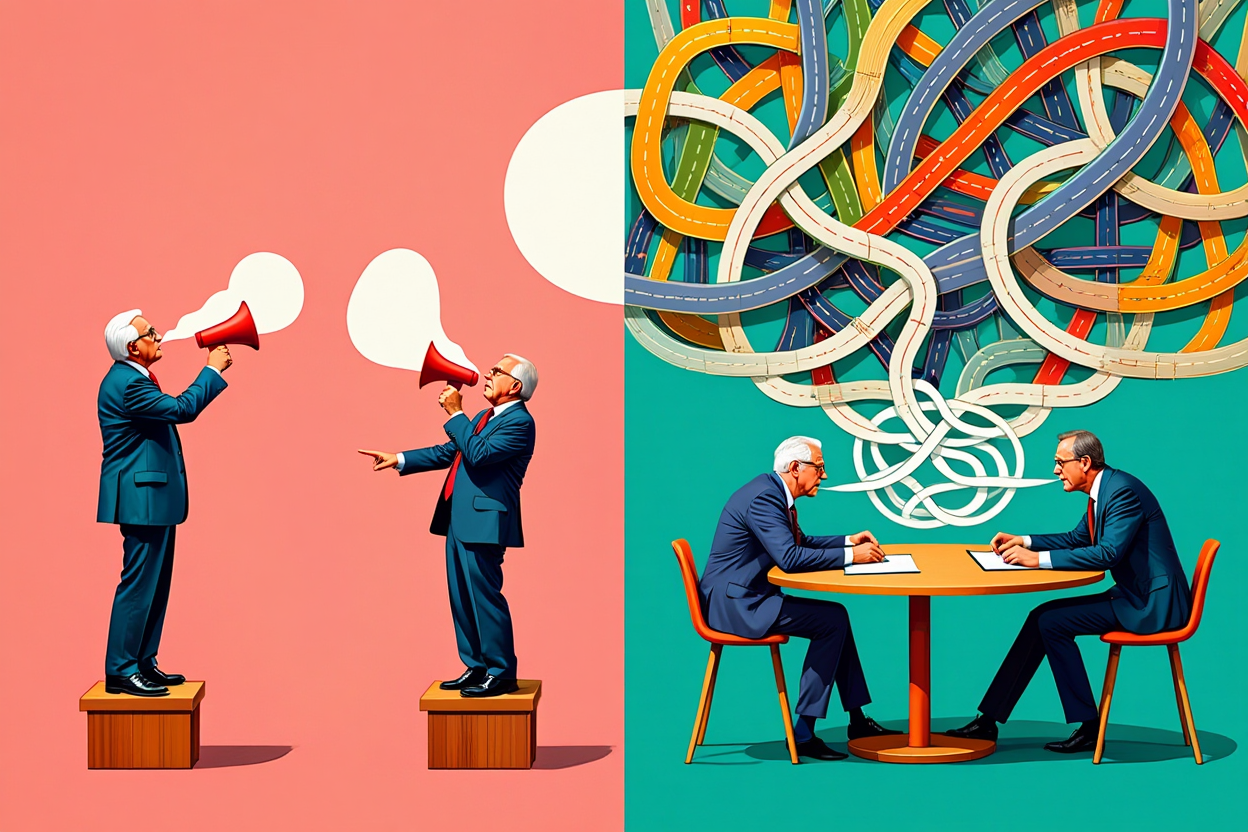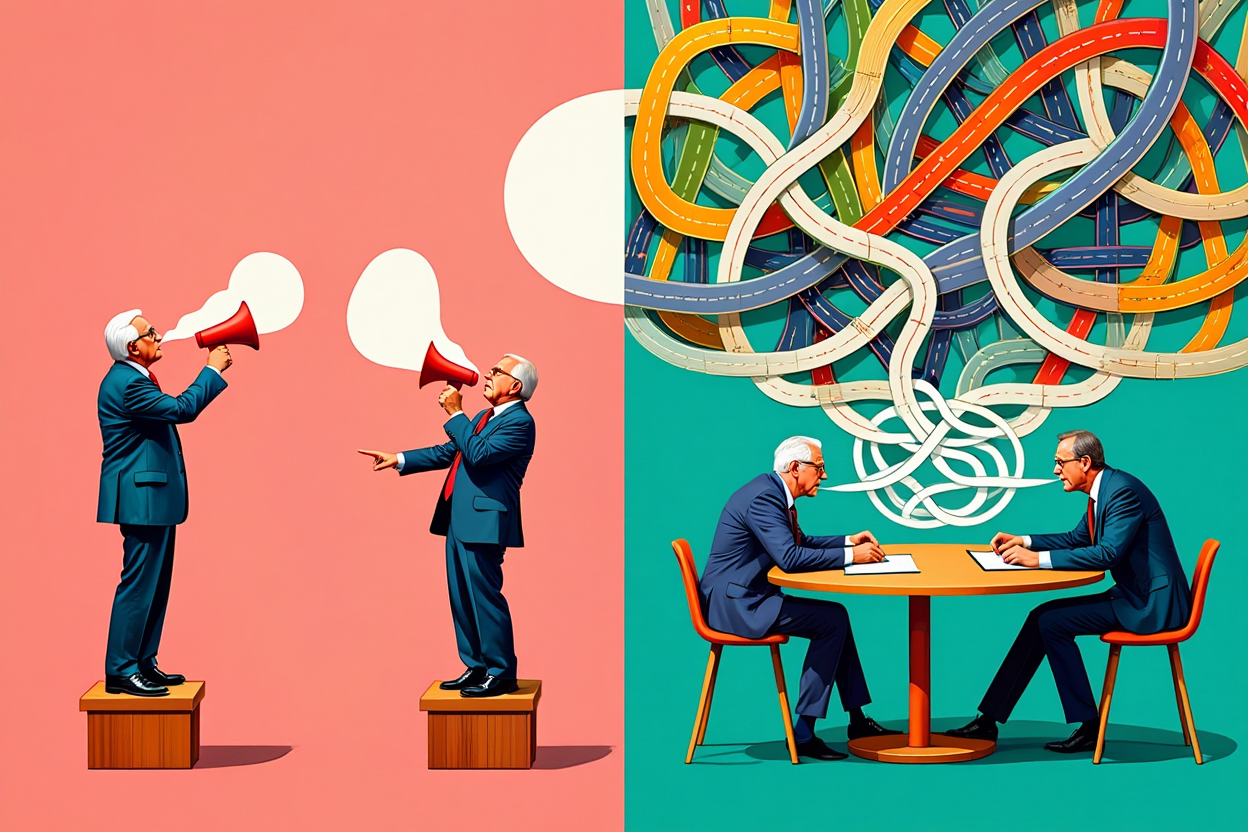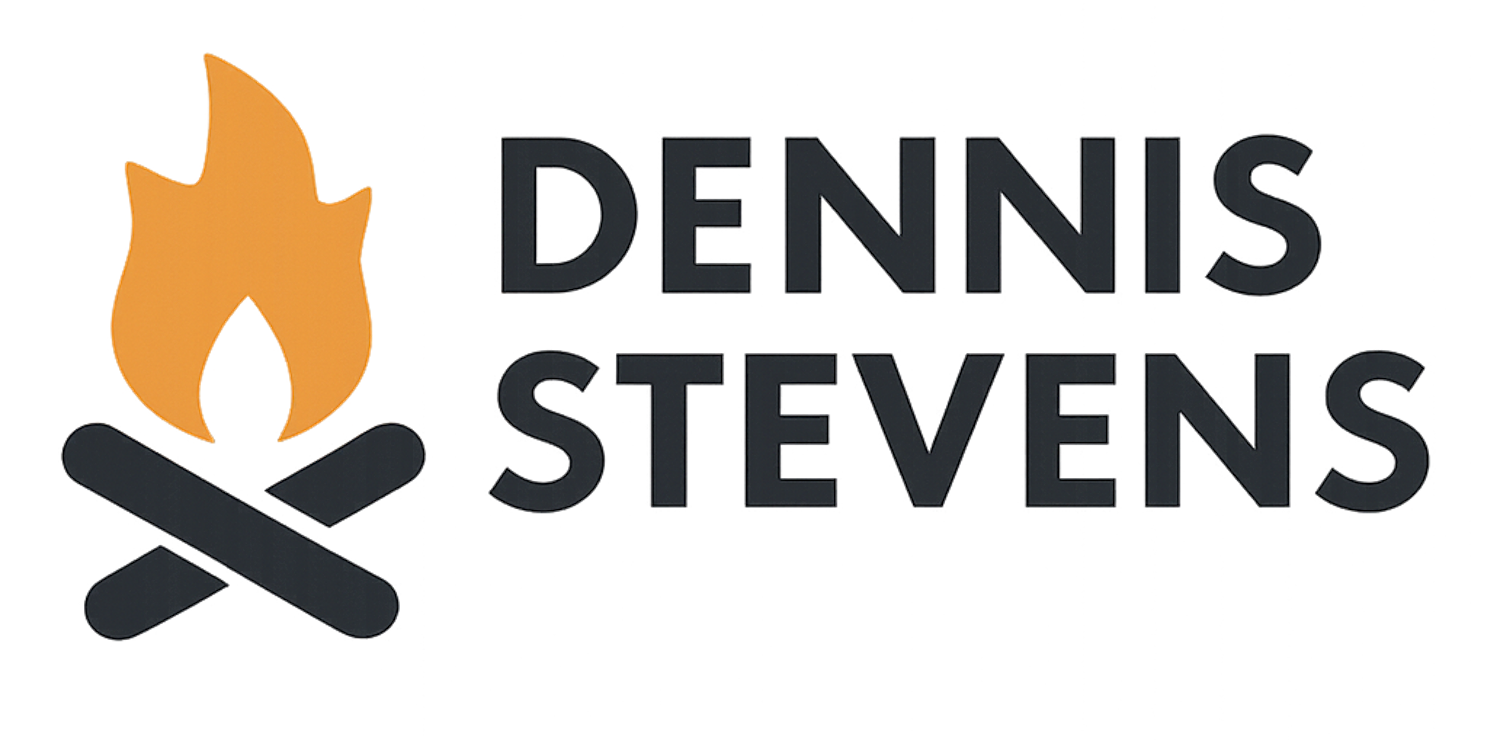Imago for Democracy
American politics loves the sound of its own voice. Beneath the noise, what we call debate is just two sides stuck in parallel monologues. To build a democracy that truly listens, we have to escape the Explanation Trap.

Spend five minutes with any American political debate and you’ll see something familiar; the noise, the confidence, the shouting, the spin, the partisan zingers, the summative soundbites, and the performative posturing. Truth is, real issue runs deeper, there are layers as to why we believe what we do. And, often, what passes for dialogue is usually two people locked in different modes of thinking about their point, as angle of persuasion.
One side lays out a problem, identifies the threat, places the blame, and predicts doom if their fix isn’t adopted. The other side does the same, but with their own facts, risks, and villains. They’re not talking to one other. They’re delivering rehearsed and performative explanations to their audiences.
There is no "point" to be won over, it's simply a rhetorical contest.
This isn’t dialogue. The Explanation Trap feeds the horserace; through this spectacle, ads are sold.
The Trap We Keep Falling Into
When we explain and predict, we’re stuck in a single way of knowing. We think we already have the truth: what’s happening is clear, who’s responsible can be summed up in a few sentences, what must be done is so apparent it is essentially self-evident; if you're not an idiot, like my opponent.
Listen to any Sunday morning political show and you’ll hear it. A politician explains a complex dilemma, warns what will happen if nothing changes, and insists they alone have the answer. If we are lucky, the interviewer pushes back with an alternative explanation, but rarely because if we're practicing "objective journalism", we have take what they say at face value and "leave it there".
It’s the same game, over and over.
As Philip Tetlock’s research on expert predictions shows, these confident prophecies rarely outperform educated guesswork or simple trendlines. But that doesn’t stop us. We cling to our explanations because they make us feel in control.
Meanwhile, nobody’s really listening. They’re just waiting for their next turn to talk, and talk they do, far too much, in my view. What’s wrong with saying, “Hmm. I need more information…”; my guess is it makes for dull television and terrible social media reels.
What Real Dialogue Demands
Authentic dialogue is different– it’s about interpretation and understanding; it requires a willingness to discover what someone actually means, not what we assume they mean. Listening is out of fashion.
Explanation is fixed and defensive. Interpretation is open and curious. You can hear the difference immediately. Someone explaining sounds certain, often rehearsed. Someone interpreting sounds exploratory, alive to the possibility that they could be changed by what they learn. Tell me more...
But here’s the catch: you can’t force someone out of the Explanation Trap. That shift is internal. It’s a choice.
This explains why so many attempts to “improve” political discourse fail. We tinker with the external, better moderators, more facts, more fact-checking, stricter rules of decorum, but the real obstacle is inside us: the willingness to be changed by what we hear; to interpret, to understand. To listen, not speak.
The fault, dear Brutus, is not in our stars, but in ourselves.

The Agon vs. the Polyphony
Literary critic Harold Bloom described the intellectual struggle between writers as an “agon”; he describes it as an arena where the larger idea swallows the smaller one.
Interestingly, in many cases, that’s how we imagine our politics: as a battle to defeat, dominate, to win and make the opposing view disappear forever. The weird thing is, we like to believe we’ve “won,” but the thing we dislike always comes back in the next election cycle, and it’s terribly inconvenient; we forget that part.
In contrast, philosopher Mikhail Bakhtin offers a different vision: polyphonic dialogue. Many voices coexisting, influencing, and transforming one another. Ideas don’t conquer each other; they adapt, they evolve, they cross-pollinate, we get over certain things and, take up new causes.
In practice, American politics is already more dialogic than we admit.
Neither major party ever eliminates the other. Instead, each defines itself in opposition, borrows what works, and shifts in response to its rival. Our system survives through friction and adaptation. It’s never a final triumph where the forces of light vanquish the forces of darkness; but, our minds crave that story, just ask George Lucas.
The infrastructure of understanding
If real progress depends on persistent, messy dialogue, then we need to treat dialogue itself as civic infrastructure. Just as we build roads and bridges to connect places, we need journalistic and civic spaces that connect different ways of knowing, especially when it comes to politics.
This isn’t about being nice or splitting the difference for its own sake. It’s about designing spaces for interpretation, not just the same old cycle of explanation and prediction.
In relationship therapy, Imago is the practice of seeing conflict not as failure but as a gateway to deeper understanding. In Imago, couples learn to stay present, listen actively, and grow together, transforming the relationship through honest dialogue. So, what if, politics could work the same way at scale? What would Imago for democracy look like?
At its core, Imago is about transforming conflict into connection by structuring how people listen to each other. In politics, where people often just trade accusations, the Imago Dialogue forces each speaker to mirror what they heard, check for accuracy, validate, and empathize before responding. This structure disrupts the usual “rebuttal mode” and invites participants to actually process what the other person means.
In politics, this could look like moderators in televised debates enforcing structured turns that require candidates to accurately summarize their opponent’s position before offering a counterpoint. In community forums, citizens might use Imago-style listening circles to work through local conflicts. Even journalists could apply the practice in interviews; moving away from “gotcha” questions toward mirroring and clarifying, so audiences better understand what a speaker truly means and where their ideas actually conflict or align.
The real challenge isn’t technical. In political discourse, the performative need to be right and look good is rooted in the reality that politicians, pundits, and even voters are often speaking to an audience, not each other. The point isn’t to explore uncertainty or admit you might be wrong, it’s to signal confidence, assert authority, and keep your “side” energized.
Looking decisive and certain, even when you’re not, becomes a performance that protects your status, wins you airtime, and feeds the endless cycle of clips and soundbites.
This performative certainty kills real dialogue because it punishes the very things that make conversation transformative: hesitation, humility, and the willingness to be changed by what you hear. It rewards rhetorical dominance over genuine understanding. So instead of conversation that connects, we get parallel monologues that feel strong but go nowhere. In the end, everyone “wins” the debate, and nobody learns a thing.
We already know how to host better conversations. The real test is internal, whether America is willing to be changed by what we hear from one another. Imagine what might happen if even a few members of our representative republic showed up with integrity, authenticity and the ability to truly listen. Back in 2004, on Crossfire, Jon Stewart appealed to the hosts with a simple truth: “…because we need what you do…”; a reminder that real debate, done well, serves the public good.
Taken together, practices like Imago Dialogue, Nonviolent Communication, and Restorative Circles offer real alternatives to our performative, zero-sum political talk. They show how structured listening, honest reflection, and genuine engagement can turn conflict into connection, helping us hear not just arguments but the needs, fears, and hopes behind them.
If we treated these methods as civic tools; not just for couples or classrooms, but for debates, newsrooms, and community decisions, we’d stand a better chance of transforming and restoring our fractured public discourse into something that can help America, rather than hurt it.
Choosing Transformation
Authentic dialogue doesn’t just trade facts, risk and blame. It generates new possibilities; ideas neither side could imagine alone. It transforms the people who participate. We can’t force that openness and willingness on anyone else. The question is whether we choose it ourselves. That choice, made again and again in conversation after conversation, might just reshape how we think together as a democracy. It starts by recognizing the difference between explaining what we already know and opening ourselves to know in a new way.
The future of American discourse depends on which solution we choose.
